Top 12 SEO Metrics that Matter for Organic Growth
Share this Article
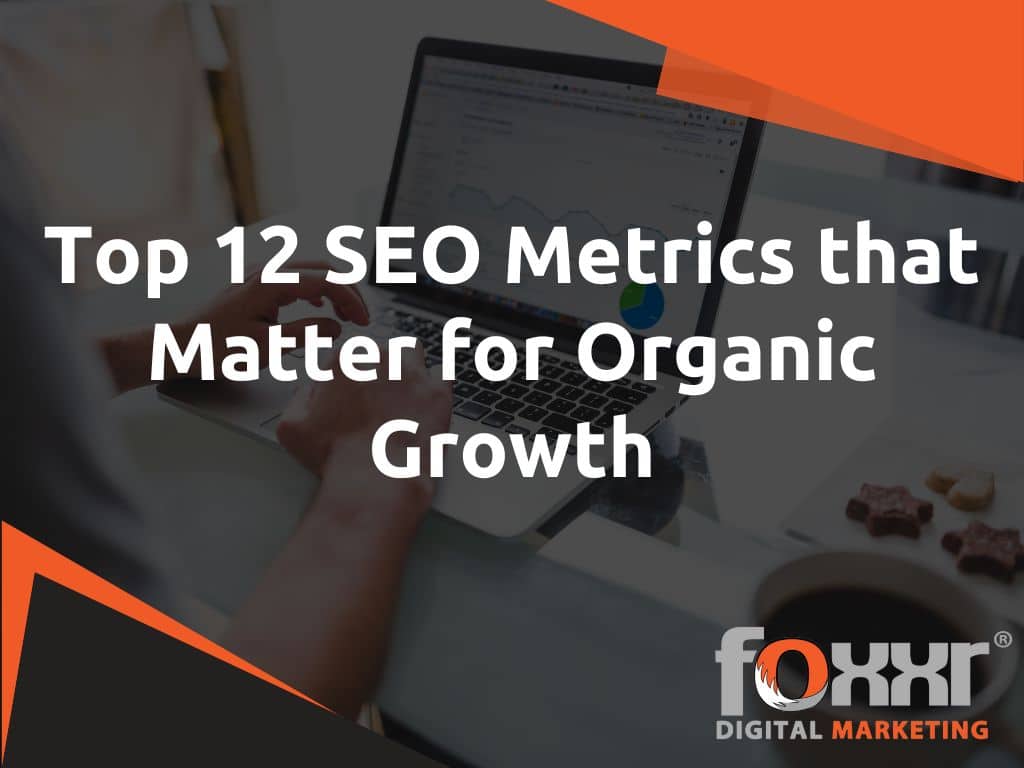
Organic search accounts for 50-55% of all website visitors. And having an effective SEO strategy is the bridge between users searching for information and clicking on your website when it appears on a search engine.
From on-page optimization to link building and core vitals, all those moving pieces work together to produce this favorable result.
But in the ever-changing SEO world, it’s essential to understand what is and isn’t working to drive that valuable web traffic. And that’s why tracking SEO metrics is a crucial part of any marketing strategy.
This article will focus on the most useful SEO metrics and how to use them to drive organic growth.
Why SEO Metrics Are Important for SEO Growth
Without quantified values, you really can’t know what’s driving SEO success or dragging you further down search rankings. These metrics also influence business decisions, so you definitely don’t want ambiguity when it comes to that.
SEO metrics give a detailed, data-driven picture of your site’s health. These insights should inform your marketing tactics and let you decide what’s working best.
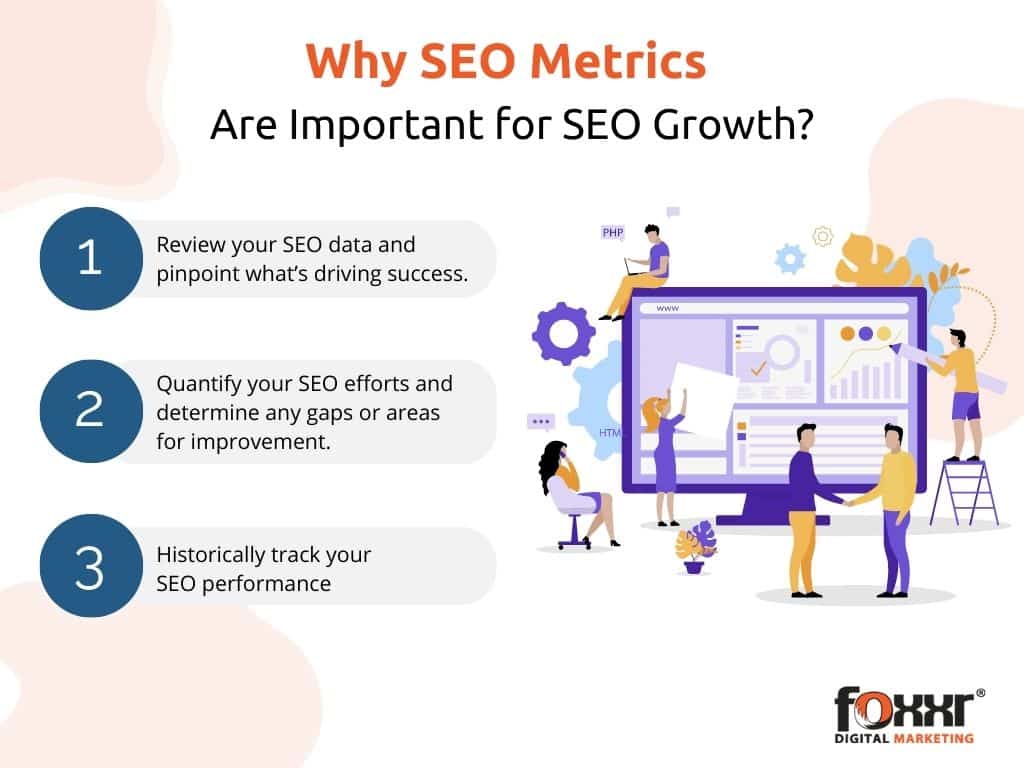
Generally speaking, keeping tabs on SEO metrics will help you:
- Review your SEO data and pinpoint what’s driving success. Once you know what works for you, you can steer your SEO efforts in the correct direction.
- Quantify your SEO efforts and determine any gaps or areas for improvement. Conversely, you’ll be able to analyze your data and identify untapped opportunities for SEO growth.
- Historically track your SEO performance. With these key insights, you can set benchmarks for your SEO performance and realistic goals.
With over 200+ SEO metrics available to track, how do you decide what’s worth looking at?
To break this down, we’ll cover the different types of SEO metrics and what to look out for.
Understanding the Difference Between Actionable and Vanity SEO Metrics
Not all SEO metrics are directly tied to your business goals. To better understand how SEO metrics work, we’ll categorize them into actionable and vanity metrics.

Actionable metrics are those SEO data points that make a difference to your business’s bottom line. These metrics give concrete insights, which should be used to make informed actions related to your business. This should eventually lead to results that tie into your long-term strategic goals.
An excellent example of an actionable SEO metric is ROI (return on investment) since it aligns with your business objectives and affects your bottom line. Other examples include organic conversions and keyword rankings.
Vanity metrics are deceitfully appealing because they’re an ego stroke and don’t necessarily impact your business or strategy.
Depending on the keywords used to calculate it, Semrush’s visibility score could count as an example. While many keywords in top positions sound comforting, not all are created equal, and not all will drive relevant traffic (which is what you actually want).
Think about it– it’s disappointing to look at glittery analytics like the number of keywords ranked or Google Search Console impressions, only to find no real user action or revenue coming from it.
And so, this type of metric doesn’t guarantee anything tangible and isn’t the best option for making business decisions.
Top 12 SEO Metrics That Matter for Organic Growth
Now that we’ve gone through the difference between vanity and actionable metrics, here are the top 12 SEO metrics you should track.
1. Keyword Volume
Keyword Volume or Keyword Search Volume is the average number of times a specific keyword is used in a search engine over a particular period. This metric tells you how popular a keyword is based on how often it is searched for.
With this insight, you’ll be able to compare search volumes and see the most relevant keywords for your content. This is important because it helps you understand how people search for a particular problem or solution.
For example, if you compare the keyword search volume between “online marketing agency” and “digital marketing agency” you can understand why our agency positions against the higher-volume search term.


Use this data to decide on the most effective keywords that correlate with user intent and what’s showing up on search engines. That way, it’ll increase the likelihood of your website appearing organically instead of just relying on paid advertising.
2. Keyword Ranking
This term refers to the organic position of your site URL on search engine results pages (SERPs) when a specific keyword is entered.
Monitoring this metric is vital since you don’t want users to scroll too far down to spot your page, especially since most users don’t scroll beyond the first page. A higher ranking for prominent keywords will also foster a greater sense of credibility and trust.

3. Organic Impressions
This is the total number of times unique users saw your site on search engine results pages–without the help of paid advertising.
The number of organic impressions is an important metric to measure the effectiveness of your SEO efforts since it gives insight into content relevance and what users are searching for.
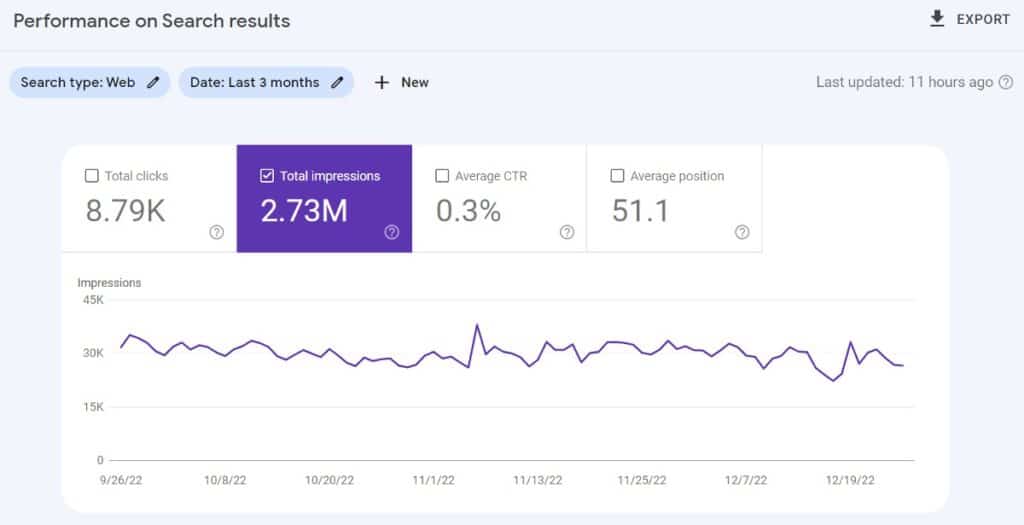
However, as mentioned earlier, it’s important that this metric ties back to relevant keywords. Gaining organic impressions for the sake of impressions alone can cost a lot of time and effort and drive very little in the way of tangible results.
4. Organic Clickthrough Rate
While organic impressions are great, you always want users to follow through on an action, such as clicking on your website. That’s where organic CTR (clickthrough rate) comes in.
Only a few users in your total organic impressions count will click on your website. Keep in mind that website clicks drive traffic to your business pages and increase visibility organically.
And so Organic CTR will tell you how much traffic you’re driving to your site’s pages (how many clicks) compared to the total impressions you made. In other words, it’s the ratio of organic clicks to organic impressions and is usually displayed as a percentage.
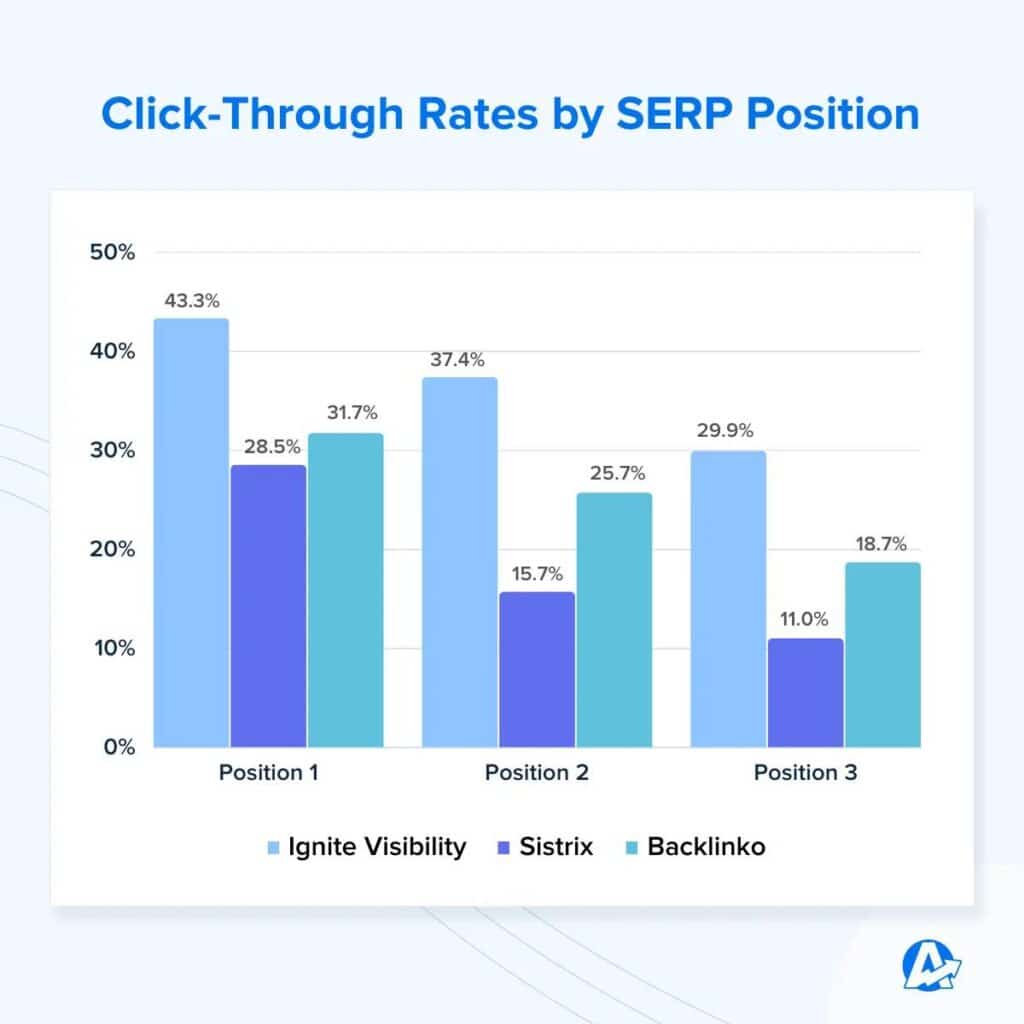
Making comparisons to your competitors’ organic CTRs will give you an idea of how your website is performing compared to others in the same industry. That way, you’ll know whether any SEO improvements are needed.
5. Organic Traffic
This metric refers to the number of users that visit your website from search engines such as Google or Bing.
One of the best ways to increase organic traffic is by publishing fresh content on your site frequently and consistently, focusing on relevant, high-quality topics that will resonate with your target audience.

A high organic traffic number is a good gauge of whether your SEO efforts are performing well. Tracking this data each month lets you know how traction is building and the effectiveness of your overall strategy.
Remember that monthly data isn’t always the best indicator of organic traffic growth if your business is affected by seasonal fluctuations. In this case, use a year-on-year comparison for a more accurate picture of progress, keeping note of any crests and troughs.
6. Organic Conversions
Not all traffic is qualified or valuable to your business. For example, you could get some organic traffic from irrelevant keywords that aren’t even related to your offering, which probably won’t result in any leads or sales.
Organic conversions are actions your visitors take on your website that meet some desired goal. Some examples include:
- Completing an online purchase
- Creating an account
- Subscribing to an email newsletter
- Sharing contact information
These actions typically revolve around lead generation or transactions, but with the implementation of Google Analytics 4, this may change in the future. Whatever event you choose as a conversion in the future, a good organic conversion rate is directly tied to your financial business goals and is also a measure of SEO success.
7. Backlinks and Referring Domains
Off-page SEO factors such as backlinks and referring domains also help move the SEO needle.
Referring domains are other websites that link to your website within their content, otherwise known as backlinks.
There’s a clear, powerful correlation between the number of referring domains and site rankings. That’s why getting more backlinks–especially from high-quality and relevant domains–is important.
On the other hand, be cautious of backlinks from questionable or blacklisted sites, as this could negatively impact your search rankings.
8. Website Authority Score
This metric takes your website’s overall SEO performance and domain quality to produce a success rating related to organic search results. A higher score means that your website likely has more depth, backlinks, and an increased likelihood of ranking favorably on SERPs organically.
It may be challenging to climb higher up this scale as it’s logarithmic, but a favorable score gives your site a real ‘authority,’ so it’s worth the effort.

Generally, a website with a higher authority score has a better chance of appearing higher in the organic rankings–especially when you are targeting highly competitive keywords with a lot of search volume.
Google (or Bing) need to figure out which site is the most relevant and helpful for the user searching for a specific team, and a website’s overall authority in that area is one of the factors they use.
9. Site Health Score
A site’s health score is a broad, overall indicator of how well your site is developed and optimized for SEO, but more from a technical SEO perspective. This number (usually expressed as a percentage) is significantly impacted by the volume of errors, and warnings spotted after your website is crawled in an SEO audit.
Wondering how to evaluate your site’s health? Various third-party SEO tools can crawl your web pages and scrutinize them for SEO-related errors.
A site health score below 50% means your site has “bad health” or needs serious attention. Conversely, a 75% or above score is “good health,” meaning your website has a strong core and is performing well. And it’s no surprise that a site scoring 90% or higher is nearly error-free.

After your website audit is complete, closely inspect your errors and warnings. That way, you’ll know what could be corrected quickly and what needs more strategic planning.
A good rule of thumb is that the errors with the most significant impact (e.g., errors) that are easiest to fix (such as broken links) should always be addressed first, and those with the lowest impact (e.g., notices) that are more difficult to improve (such as page click depth) should be addressed last.
10. Core Vitals
Google wants a great user experience for its visitors, and a fast-loading page is a major factor contributing to that. A good page speed leads to higher conversion rates. Conversely, conversion rates drop significantly when a page takes too long to load.
In 2021, Google expanded on this metric and introduced Core Web Vitals as a search ranking factor. This makes fixing any issues surrounding loading times especially crucial to ensure a decent ranking.

Core Web Vitals is a set of metrics used to measure your website’s general speed and stability in a more detailed way. It includes data on three facets of user experience: loading, interactivity, and visual stability.
Core Web Vitals (CWV) includes these three important SEO metrics:
- Largest Contentful Paint (LCP): The time taken to load the largest individual element on your website fully
- First Input Delay (FID): The time gap between a user interacting with a page and when the page becomes fully responsive
- Cumulative Layout Shift (CLS): How often elements on a web page shift around unintendedly. Elements that suddenly pop up may break a reader’s flow and force them to reposition their interface. Therefore, a high CLS score would thus indicate an unstable page layout. A low CLS indicates stability and a generally uninterrupted user experience.
11. Bounce Rate
Your website’s bounce rate shows the percentage of visitors that land on your site but take no further action (e.g., going to another page, leaving a comment, or adding items to a shopping cart).
In other words, this rate measures how many users load a single page and “bounce” back out of the site.
A high bounce rate can indicate that something’s not right, either with your overall website or particular pages that users are leaving without interacting with your website. If these issues aren’t addressed, you may miss out on opportunities to engage your audience or even get conversions.
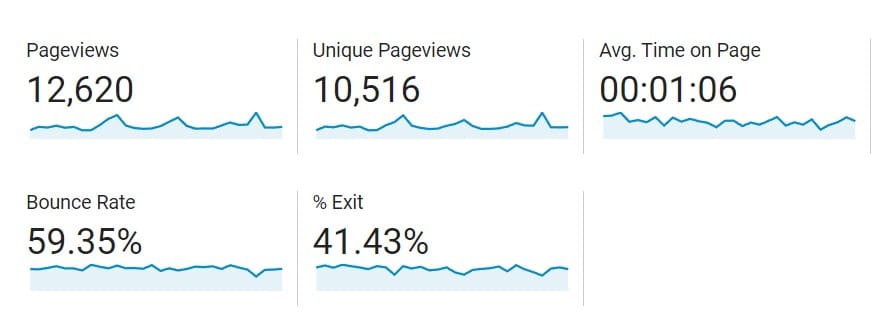
Although bounce rates don’t directly impact your site’s ranking, many marketers take this SEO metric seriously (and rightfully so).
To provide your visitors with great user experiences and to reduce bounce rates, take the following measures:
- Reduce page loading times
- Make sure your web pages are relevant to targeted users’ needs
- Put important things on top of the page
- Let users know the gist of web page content at first glance
- Ensure web pages have visual and aesthetic appeal
- Use easy-to-read, skim-friendly text
- Publish genuinely good content that entices users to engage with your site more
- Avoid elements that dampen user experiences, such as pop-up ads or difficult navigation
Focus on identifying and improving the web pages with high bounce rates for optimal results.
However, it’s important to remember that bounce rates will fluctuate based on the type of content the user is reading. For example, blog posts tend to have a higher-than-average bounce rate, even if the user spends 10 minutes thoroughly reading the post.
That’s one of the reasons that Google is changing the definition of bounce rate in GA4.
12. Mobile Performance
More than 50% of all internet searches are via mobile devices these days. And keeping track of your mobile traffic helps you understand whether your website is mobile-friendly.
Since Google has now adopted mobile-first indexing, optimizing your site for mobile ranking is a priority. If your mobile traffic is stagnant or decreases–even if your overall traffic is increasing–it might point to mobile-friendliness issues on your site. You may also want to research and use mobile-only search terms to climb the algorithm for mobile rankings.
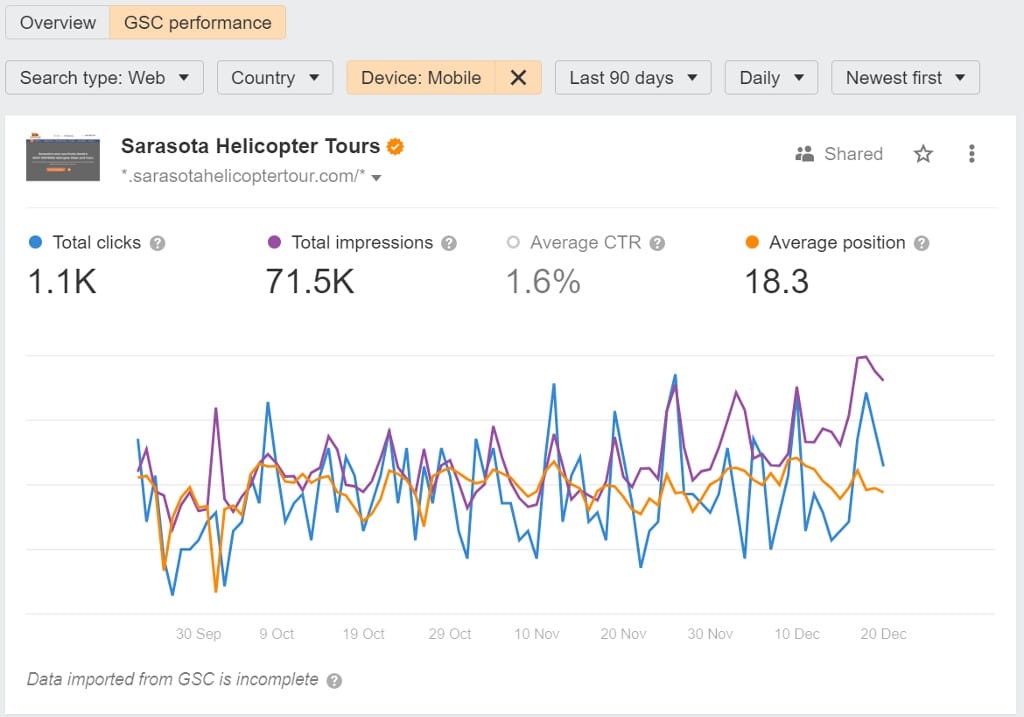
Also, check if your website appears in the same search ranking spots for mobile and desktop searches.
How To Track SEO Metrics
Even if you’ve decided to track just a few SEO metrics, it takes a lot of different SEO tools to keep on top of that data. For example, you could use a combination of Google Analytics, Google Search Console tools, and third-party tracking tools (e.g., Ahref and Semrush) to see what’s happening.
However, relying on this multi-channel approach will take a lot of time and energy. If you’re not fully versed in the intricacies of SEO management, it’s a good idea to hire a professional. That way, you won’t have to navigate through a plethora of data just to understand if your SEO efforts are working.
An experienced professional could also add context to SEO metrics. For example, you may observe high keyword rankings but a low organic conversion rate. You may wonder what’s the problem and how to resolve it. In this case, an expert could gather more insights from organic sessions, bounce rates, and other data points to create a story of what’s happening.
Another option is using an SEO report template that consolidates data and won’t overwhelm you with thousands of numbers. You’ll also be able to customize it in a visually appealing, understandable way. And if you’re tracking a variety of SEO metrics, you won’t need to navigate multiple platforms anymore. That means more time and less hassle!
Summary & Key Takeaways
SEO is an important way to grow your business digitally. And the only way to guarantee success is by tracking data and understanding what’s happening.
Clearly define your business goals and use these SEO metrics to keep tabs on the data points that matter. That way, you’ll know what needs to be improved while strengthening your SEO footprint over time.
